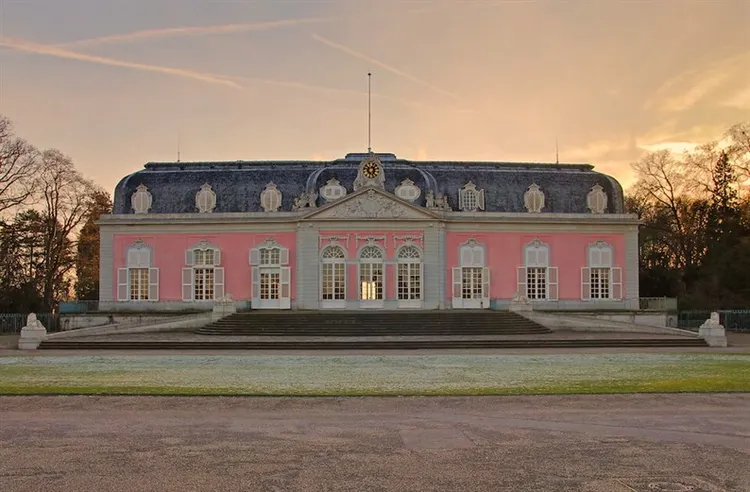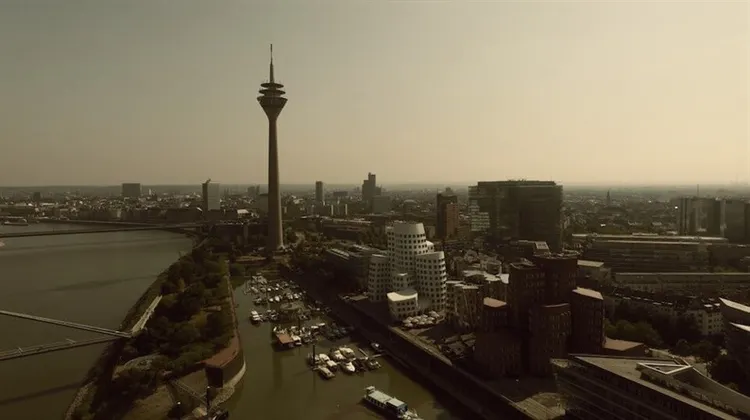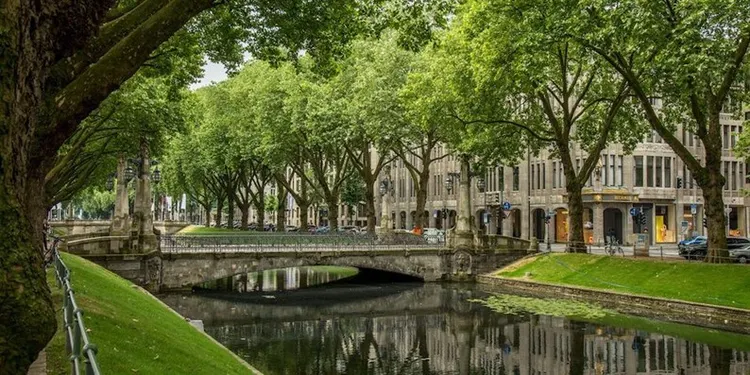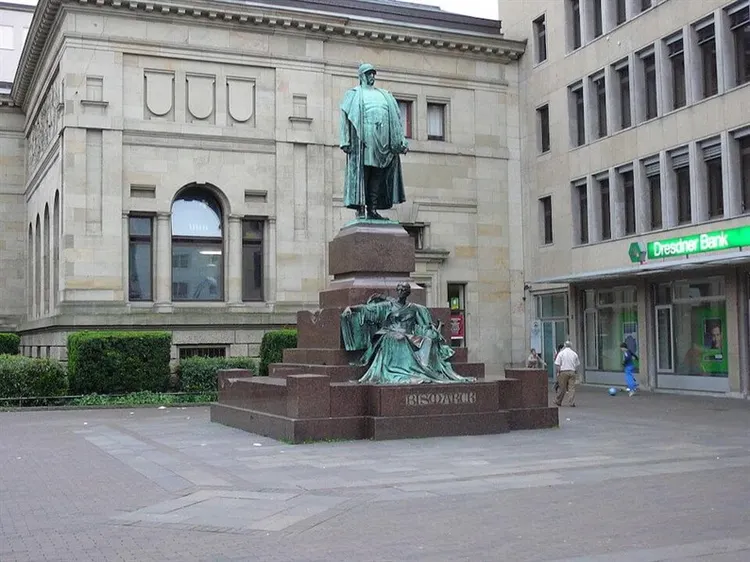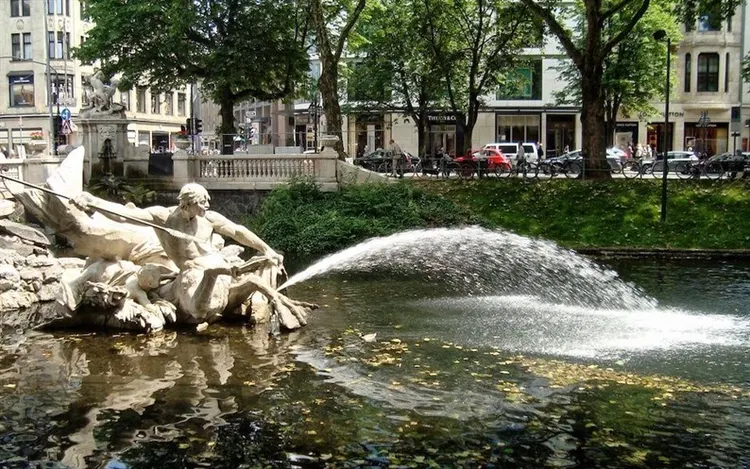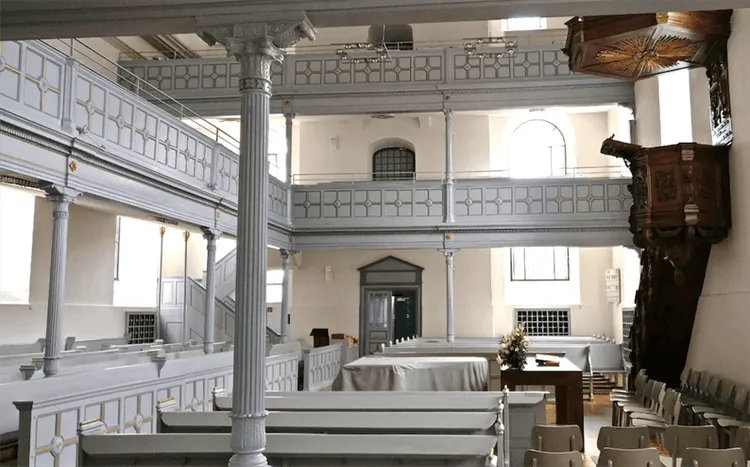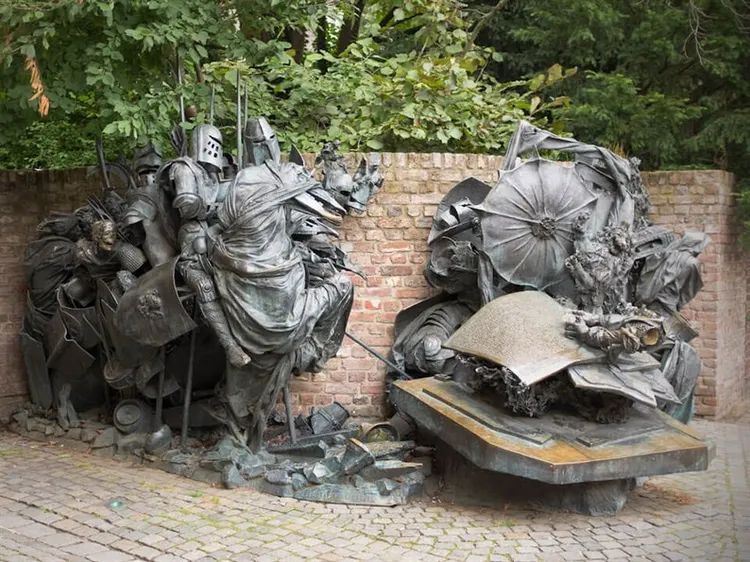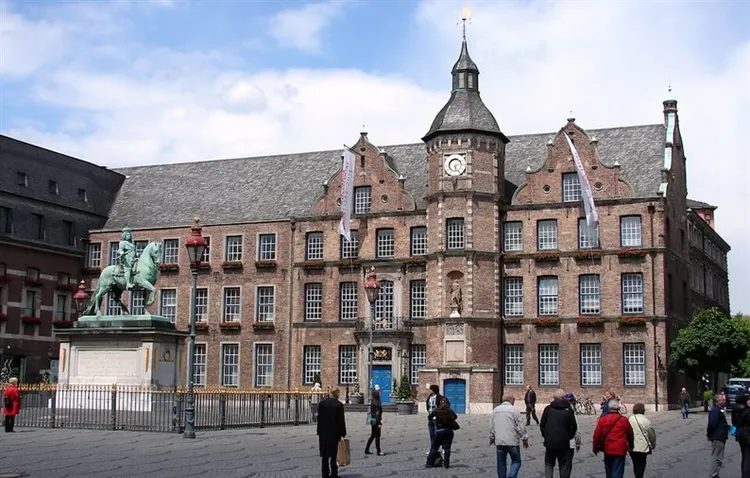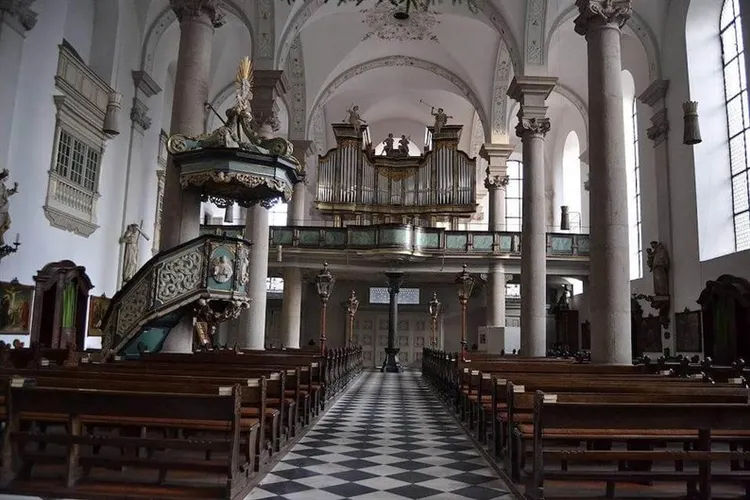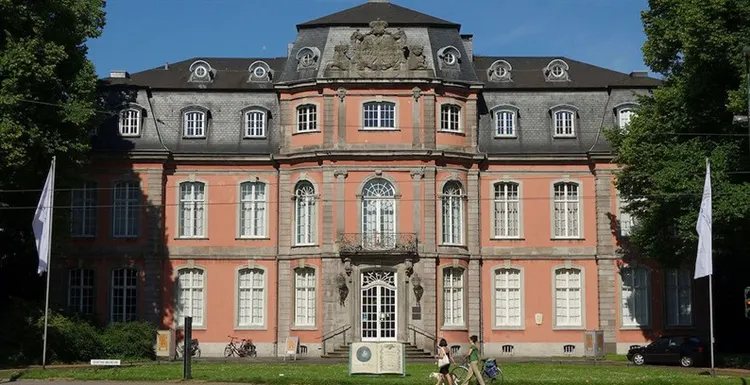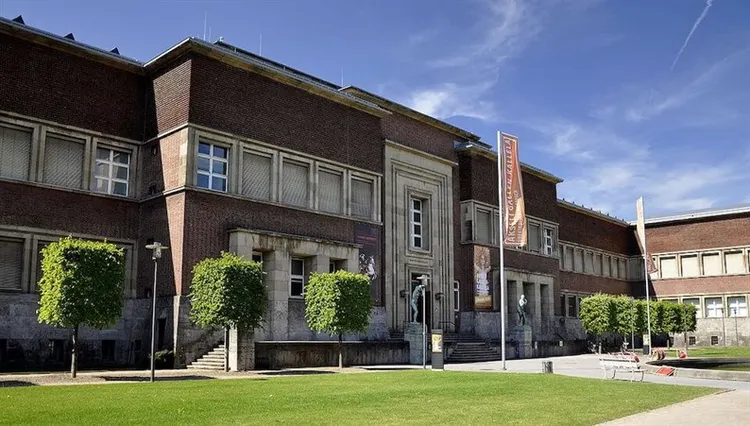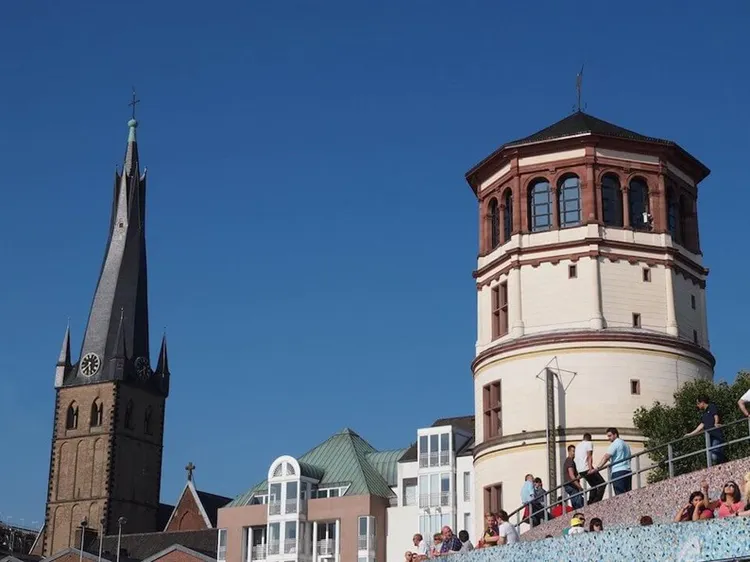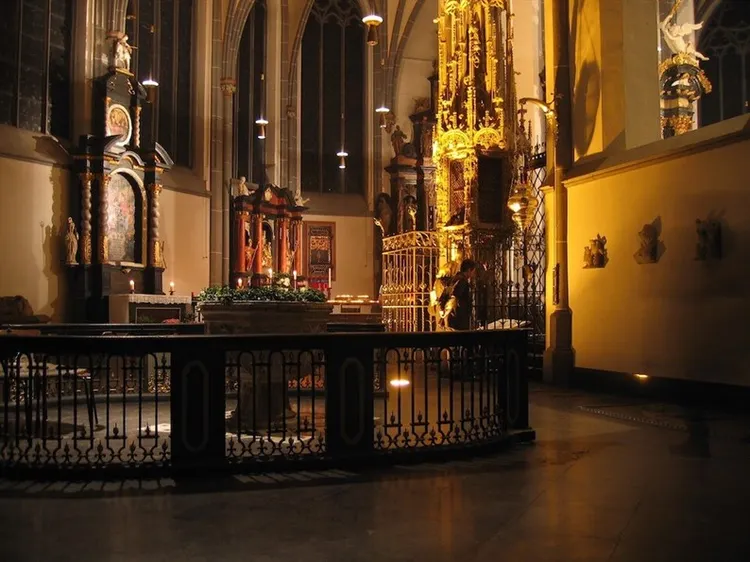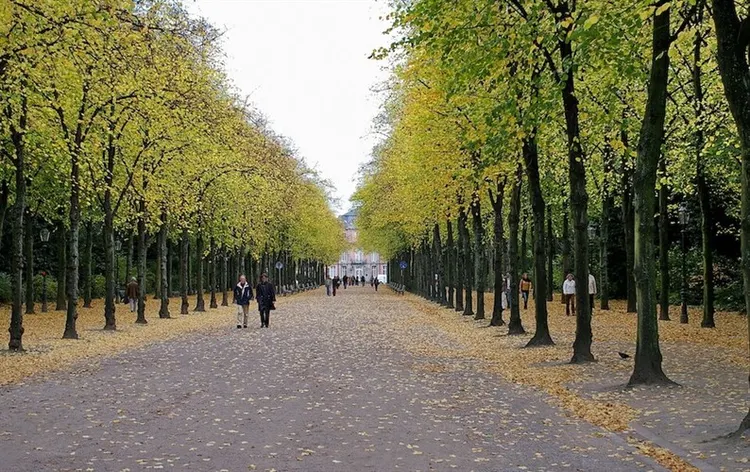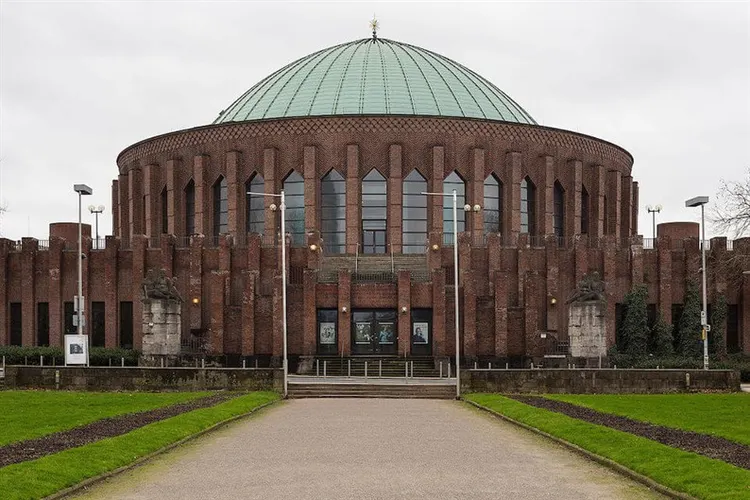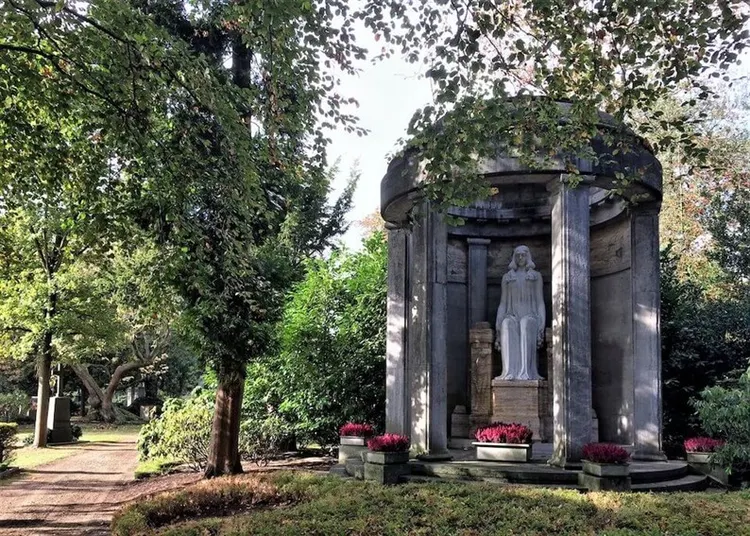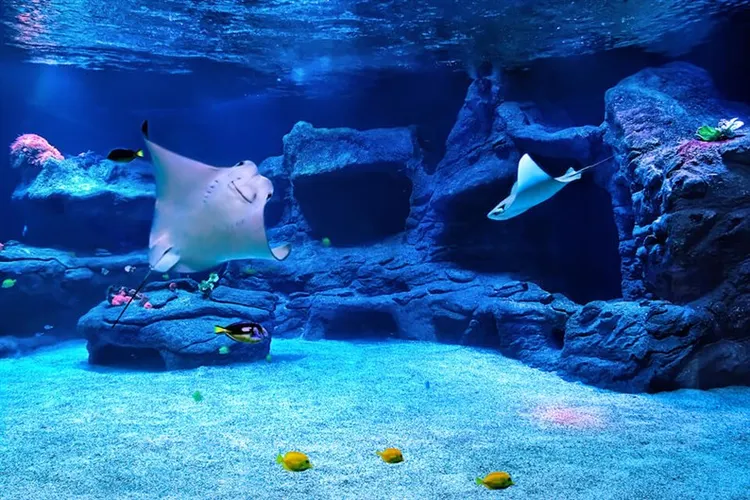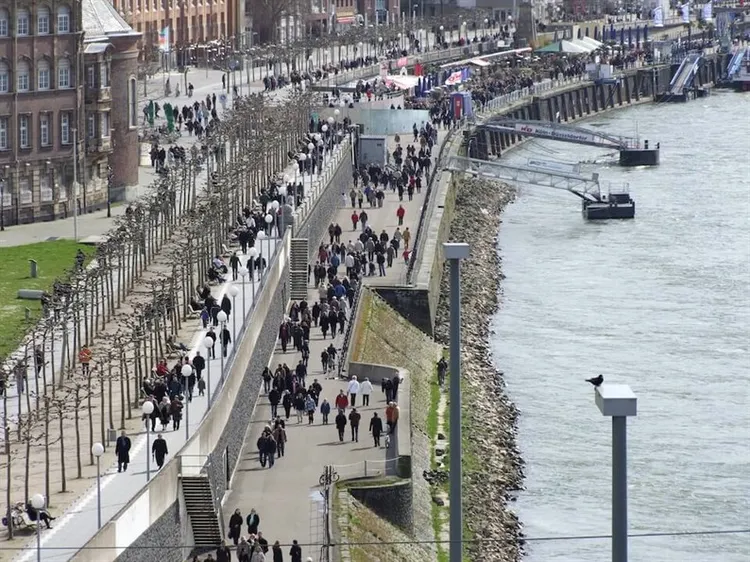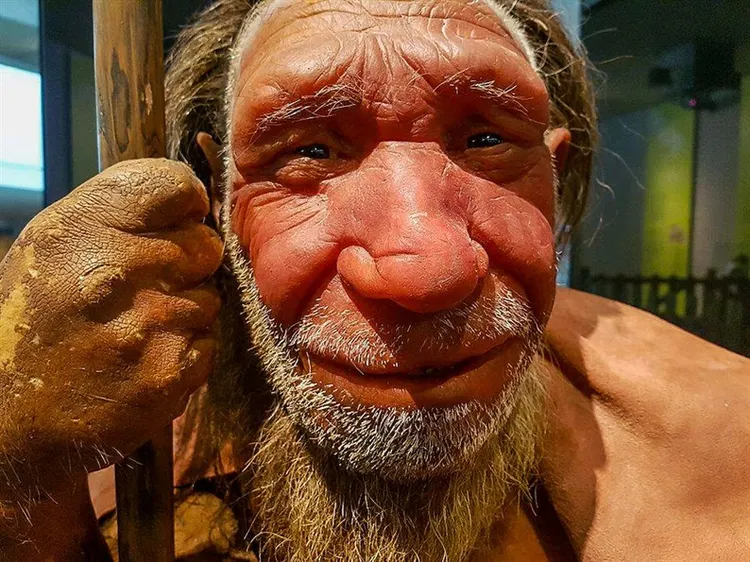The city of Düsseldorf, located in the west of Germany, received city status in the 12th century from a village near the Rhine, is listed as the capital of the federal state of North Rhine-Westphalia. The blue ribbon of the river divided the city in half, separating the modern districts from the ancient Altstadt, located on the east bank. There are many interesting places in the city, famous for its originality and elegance. Find out what to see in Düsseldorf in 1 day to enjoy its charming atmosphere, leaving fond memories of this day in your memory.
How to get from the airport to the center
The main gates of the city open for guests at Dusseldorf International Airport, located in the city, 7 km from the historic center. All three terminals A, B, C are located under one roof and it is convenient to move between them on foot. You can also use the free monorail Sky Train, which runs in 3-7 minutes from the terminals to the parking lot and the railway station.
Metro (S-Bahn) is a convenient and inexpensive option to get to the center. You will find the station at terminal C. By metro, it takes 12 minutes to reach the central railway station. Tickets worth 2.6 € are purchased at the station at the ticket machine, indicating the final stop Dusseldorf Hbf.
Buses leave for the center from the bus station located next to the main hall of the airport, being on the road for up to 20 minutes. Route No. 721 will take you to the central railway station and route No. 896 – to the Düsseldorf-Messe trade and exhibition center. The fare on all routes costs 2.3 €, buses do not run at night. A taxi around the clock will reach the center for 24 € in 10-15 minutes. You will see special taxi ranks near each terminal, where cars are ordered at the racks.
🏨 🚕 Individual transfer from the airport to the hotel and more
Benrath Castle
The view of the exquisite Benrath Castle, located on the banks of the Rhine, adorns the Benrather Schloßallee street of the same name. It was built for Elector Charles Theodor from 1755 to 1770 according to the design of a French architect in the then fashionable rococo style with the addition of architectural details of the emerging classicism. The palace complex harmoniously combined architecture with gardening art. The main building, flaunting near the pond, is expressed in the form of a pavilion crowned with a dome with adjoining outbuildings.
Alleys lead from the French-English style park to the banks of the Rhine. The interiors of the palace impress with wall paintings, marble decor, skillful statues, luxurious furniture, paintings depicting the seasons, hunting and peasant scenes. Tourists visit the palace with interest and the Museum of Natural History and the Museum of Landscape Art of Europe located in it.
The castle welcomes guests: from Tuesday to Sunday 16.04 to 31.10 from 10.00 to 18.00; from 01.11 to 15.04 – from 11.00 to 17.00.
Rhine TV Tower
On the waterfront of Düsseldorf, the Rheinturm TV tower attracts the eye – the highest building in the city, reaching 240 meters high. The tower, which looks like an alien plate, has become a recognizable symbol of Düsseldorf and the best observation platform of the city, located at an altitude of 166 meters. Rising there by elevator, a wonderful view of the city's attractions will open. The architectural highlight of the site was the angled window panes, on which you can lie down for a better view of the city.
Worth a visit on the tower is the rotating restaurant located one floor above the observation deck. Sitting at a table with a glass of drink, it is pleasant to see the circular panorama of Düsseldorf from there. The television tower is listed in the Guinness Book of Records thanks to the world‘s largest luminous clock, where time, illuminated by 62 lamps, must be read from top to bottom: first hours, then minutes and then seconds.
The observation deck can be visited from 10.00 to 22.00, and on Friday and Saturday until 1 am. The restaurant serves from 10.00 to 23.00.
royal alley
The Royal Alley stretches across the entire Alstadt from north to south. It is a boulevard bordered by chestnut trees and divided in the center by a kilometer-long canal 30 meters wide. As a rule, from the Royal Alley, which crosses all the streets of the old city, tourists begin their acquaintance with Dusseldorf, heading from the railway station.
The alley delights the eye with lush greenery, skillful sculptures, the famous fountain, beautiful bridges and wrought-iron benches. Königsallee with numerous boutiques of famous fashion houses is a paradise for shoppers. In addition, it is notable for its cultural attractions: the Theater Museum, the German Opera, the Drama Theater and an exhibition of works and things by Goethe.
Monument to Bismarck
The merit of Otto von Bismarck, nicknamed the “Iron Chancellor” – the unification of German lands into an empire. A copper monument to the first chancellor of the empire, recognized in the world as an outstanding politician of the 19th century, was opened in 1899 on Luther Square, placing it near the monument to Emperor Wilhelm I, whom he faithfully served. The courageous figure of the “Iron Chancellor” leaning on a sword and striving forward, rises to his full height on a pedestal.
On one side of the pedestal is a sculpture of a warrior holding a bunch of oak beams in his hands, symbolizing the unification of the German people. On the other hand, we see the figure of a woman with a hammer in her hands and an anchor under her feet – the personification of Germany and Düsseldorf, spread along the banks of the Rhine. The tandem of monuments creates an interesting architectural ensemble next to the Church of St. John, which stands out among them with neo-Gothic architecture.
Fountain “Triton”
The Triton Fountain, which adorned the Royal Avenue at the northern end of the canal, was installed in 1902. Since then, his sculptural composition has become a hallmark of Düsseldorf. The center of the composition attracts attention with a sculpture of the herald of the deep sea – the mythological Greek god Triton, thrusting a trident into the body of a huge toothy fish. Small children are hiding behind Triton from the sea monster.
An expression of fear was reflected on the petrified children's faces. The fountain ensemble is complemented by a skillful bench made of the same stone as the fountain. Tourists love to take pictures near the “Triton” and watch the fish swimming near it.
Hop-on hop-off city tour – 15 €
Tourist card DüsseldorfCard – from 9 €
Neander Church
The Protestant Neander Church was built at the end of the 17th century in the Baroque style in the depths of Bolkerstraße. A small church building with a tower towering several floors in the center and attached buildings from the sides does not stand out for its luxurious decor. The eye is attracted by the clock mounted on the tower, striking with the impressive size of the dial.
The spacious interior of the temple, decorated in light colors, is richly decorated with stucco on the vaults, walls and columns. Along the walls are statues of saints revered by Protestants. The temple is famous for its extravagant organ created by Austrian masters in the middle of the last century. Its sound is heard by parishioners and tourists at concerts held in the church.
You can visit the temple from Tuesday to Saturday from 10.00 to 18.00 for free, by metro lines: U70 and U74 – U79 to the Heinrich Heine Alley stop.
Monument in honor of the 700th anniversary of the founding of the city
On the occasion of the 700th anniversary of the founding of the city of Düsseldorf, the sculptor Bert Gerresheim erected a bronze monument on the Castle Square. The sculptural composition of the triptych is embodied in 17 historical subjects, read from left to right. In the center there is a charter with the seals of Count Adolf von Berg, testifying to a significant event, a shield with the image of a “Lip rose”, a figure of a Berg lion and an anchor. The city symbolism is complemented by a market plot illustrating the peaceful life of the city.
The left side depicts peasant militias with primitive weapons and knights on horseback in the battle for independence led by Count Berg. The right side of the monument, depicting a monk holding a shrine with the relics of St. Apollinaris and four Popes, reminds of the abbey founded by the count and the spirituality of the townspeople. The triptych is interspersed with modern objects that embody the continuity of generations, moral values and the problem of violence existing in the world.
old town hall
On the main square of the city of Markplatz, an old building entwined with ivy, built of red brick, attracts the eye – the City Hall. The three buildings that make up the architectural ensemble of the town hall today were built at different times, so each part of it is expressed in its own style – late Gothic, Baroque and Neo-Renaissance.
The central building, dating back to the 16th century, has been the place of work of the burgomaster for 5 centuries. In the town hall, the gothic octagonal tower with a statue, a clock and openwork tongs on the pediments attracts the eye. In the 18th century, the central facade was embellished with rococo details, adding pilasters and adding an openwork balcony above the main entrance, from which the burgomaster congratulates the people on the days of celebrations.
Inside the town hall is interesting with an abundance of artifacts and a portrait gallery of all ex-burgomasters. Here you will see the memorial room of Goethe with a bust of the poet, a collection of his letters and drawings. The only way to get to the town hall is on guided tours, which take place on Wednesdays at 15.00. It is convenient to get to Markplatz, passing one block along the embankment from the Castle Tower to the northwest.
Church of Saint Maximilian
The Church of St. Maximilian, founded by the Frascican monks in the middle of the 17th century, played a big role in the spiritual development of the city. There was a religious school attached to the church, and to this day there is a parochial school where the famous German poet Heinrich Heine studied.
People come here to see and listen to an organ of extraordinary beauty, decorated with figures of angels of music, on which famous composers Felix Mendenlssohn-Bartholdy and Robert Schumann played at masses in the 19th century. The church interior impresses with paintings by Rubens and many artistic masterpieces.
In the inconspicuous chapel of the temple, parishioners and tourists go to bow to the famous icon “Madonna with merciful eyes” by Rubens. You should go to the church by trams: No. 703, 706, 712, 713 to the Benrather Straße stop. The church is open all week from 10.00 to 17.00. On Saturdays and Sundays at 18.00 there are evening masses.
Goethe Museum
Although Goethe never lived in Düsseldorf, a museum dedicated to him was opened in the middle of the 20th century in the elegant castle-palace Jägerhof, built in Rococo architecture in the middle of the 18th century. Its luxurious building adorns the Jacobi street opposite the city park Hofgarten. Arriving in Düsseldorf, the poet stayed at the house of the Jacobi family, which was not far from the Jägerhof castle, so the authorities decided to open the Goethe Museum here. The exposition is based on the private collection of the Leipzig publisher Anton Kippenberg, donated to the city by his heirs.
The museum halls feature over 50,000 exhibits dating back to the 18th century: paintings, medals, busts, coins, manuscripts and letters, and 17,000 books, 3,000 notes. Of particular value is the collection of minerals personally collected by Goethe. A separate hall, called the Faust room, is dedicated to the development of the plot, artistic and musical works on the theme of a brilliant creation. Here you will find original illustrations for Faust by Peter Cornelius, lithographs by Delacroix and etchings by Salvador Dali.
The museum is open: Tuesday-Friday and Sunday from 11.00 to 17.00, Saturday from 13.00 to 17.00.
Museum of the Kunstpalast
On Heine Alley, opposite the Grabbeplast Square, the “U”-shaped building of the beginning of the last century, expressed in the style of expressionism, attracts the attention of tourists. The extravagant building houses one of Germany's most important museums, the Kunstpalast. The core of the museum's collection are works of art that belonged to Elector Johann of the Palatinate and his wife Anna de' Medici in the early 18th century.
Now the Kunstpalast collection has almost 100 thousand exhibits: paintings, sculptures, engravings, glassware and contemporary art. In the museum's art gallery, the picturesque masterpieces of Rubens “Venus and Adonis” and “The Assumption of the Blessed Virgin Mary” are of particular value.
The graphic hall exhibits 70,000 works of the 15th-20th centuries, among which the graphic works of the outstanding artists Raphael, Michelangelo, Altdorfer and Veronese are of particular interest. The variety of statues and sculptural compositions is amazing, and the exhibition of glass exhibits makes it possible to see with your own eyes what crystal objects were used by the monarchs and the elite of the 17th-19th centuries.
The Kunstpalast is open: Tuesday – Wednesday, Friday – Sunday from 11.00 to 18.00, Thursday – until 21.00.
castle tower
Simultaneously with the acquisition of the status of the city at the end of the XII century, they began to build a castle, inside of which there was a square – Burgplatz. Over the centuries, the castle was destroyed by numerous fires, the last of which in 1872 destroyed it completely, beyond restoration. The only building that has survived from the XIV century from the Düsseldorf castle is the small Castle Tower on the Burgplatz square, where every stone keeps the tragic history of the castle's catastrophes.
The tower now houses the Museum of the History of the Rhine, which displays more than 120 models of boats and steamships representing the history of shipping from ancient times to the present day. The museum is open to visitors from 11.00 to 18.00. In the “Lantern” of the tower, tourists like to relax in the panoramic restaurant, which offers a circular view of the Allstadt, with views of the embankment and the Rhine TV tower.
Basilica of Saint Lambert
The building of the most respectable age in Düsseldorf is called the Basilica of St. Lambert. Its history begins with a small chapel built by St. Willeik on the spot where the Düssel River flows into the Rhine. After 7 centuries, the Basilica of St. Lambert on Stiftsplatz attracts the eye with historical sculptural compositions of portals. On one portal we see Golgotha with Christians crucified for their faith and mourners bowing their heads near the crosses.
Another composition depicts the story of Düsseldorf's independence, the Battle of Worringer, where knights in armor, peasant militias and weapons are depicted in precise detail in confrontation. Inside, the temple delights with a luxurious baroque altar, a statue of the Blessed Virgin Mary, located on a column, and wall paintings of the 15th century.
The holy relics of the basilica venerate the relics of the Blessed Apollinaris of Ravenna, patron of Düsseldorf, St. Lambert, St. Willeik. The parishioners bow to two miraculous icons – Mary the Conqueror and Mary the Helper. The Basilica is open daily from 9.00 to 18.00. You can get to it by metro U70, U74 – U79, getting off at the Heinrich-Heine-Allee station.
Hofgarten park
The oldest city park Hofgarten, founded in the 18th century, is the central park of Düsseldorf, made in the traditional English style with late baroque architectural forms. At the entrance, visitors are greeted by a monument to the artist Peter Cornelius, then shady alleys lead to ponds with black swans and other waterfowl, to cozy corners for relaxation. Here it is a pleasure to watch flying green parrots and hand squirrels.
It is especially beautiful here on summer evenings on the alley leading to the hunting castle, where the enchanting atmosphere is created by benches illuminated by neon light. The alleys of the park are decorated with sculptures that embodied the heroes and events of past eras in stone. Fountains, the picturesque shore of Lake Landskrone and the Neanderthal Museum give a special charm to the landscape. Tourists love to take selfies near the compositions, where children look at the frog and the bronze baronesses.
You can get to the park by trams No. 701,706,715 to the Sternstraße stop.
Concert hall “Tonhalle”
The view of the Tonhalle is not architecturally associated with a traditional philharmonic hall. The design of the building, which was built in 1926 for the planetarium, belongs to the famous architect Wilhelm Kreis. In the post-war years, it was rebuilt as a concert hall, leaving it with a central dome, reminiscent of the original purpose of the building. The Tonhalle dome, shining like gems inside, is considered a masterpiece of modern art.
An enchanting radiance is given by a unique chandelier with many mirrors located in the center of the dome, created according to the sketches of the painter Adolf Luther. The spacious foyer with a beautiful mosaic floor is flooded with light from original lamps. The auditorium has a rounded shape with walls decorated with picturesque panels, paintings and is equipped with comfortable chairs.
Many symphony orchestras, outstanding musicians, opera and pop stars perform at Tonhalle, which has been dubbed the “Coliseum of the 20th century”. To look at it, take the metro lines U70, U74 – U77 to the Tonhalle / Ehrenhof station.
Dusseldorf Observatory
Düsseldorf-Bilk – an observatory, created at the expense of Johann Friedrich Benzenberg in the district of the same name, began work in 1843. Three years after the death of the founder, the observatory became the property of the city. Observations of the starry sky were carried out with a long-focus refractor, and since 1874 with the powerful equatorial of Carl Bamberg. With the help of these telescopes, 24 asteroids were discovered in the 19th century, called by astronomers “24 Düsseldorf planets”.
In recognition of the merits of the observatory, one of the asteroids is named Bilk. During the Second World War, the observatory was bombed and completely burned down. Today, on the site of the former observatory on Bachstrasse Street, a 40-meter monument has been erected in the form of a telescope that burned down from the bombardment. This place is located 2.5 km south of the Basilica of St. Lambert.
Holzheimer Cemetery
The Holzheimer cemetery, located in a picturesque landscape area, is called the historical book of Düsseldorf. The famous churchyard with more than 50 thousand graves, located on the northern outskirts of the city, is 130 years old. Most of the tomb sculptures made in the 19th century amaze with their skill and originality. “Million Hill”, where the owners of huge fortunes are buried, like an open-air museum, stands out with monuments made in the styles of neoclassicism, renaissance and modernity.
Among them are the tombstones of the family of the owner of the Henkel plant, the owner of the steel plant, the owner of the Veba company and other rich people, created by famous architects. Near the hill of millionaires you will see tombstones and sculptures of the cultural and political elite. On the territory of the Northern Cemetery, visitors are especially interested in the last shelter No. 50 of the still living Riemenschneiders. The beautiful mausoleum, built in an environment of trees by the famous Dutch architect from hewn limestone, impresses with frescoes, mosaics and decorative windows.
At the main entrance to the cemetery, not far from the Theodor Heuss bridge, there is a neo-Gothic chapel, from where a sightseeing walk begins. The churchyard is open around the clock. You should go to it from the main station by metro U78/79 to Theodor-Heuss-Brücke station and then walk 700 meters on foot, focusing on the chapel.
Aqua Zoo and Museum Löbecke
“Aqua-Zoo” water zoo and natural history museum Löbeke – a single complex, spread over the territory of the Nordpark. Fish, reptiles, sharks and turtles live freely in equipped aquariums. Protected from visitors, the shores of water bodies have become a habitat for fur seals and penguins. In terrariums it is interesting to observe the habits of snakes and many species of reptiles. Getting into the tropical forest of the zoo, you see hummingbirds and bright tropical butterflies flying overhead, and lazily dozing crocodiles in the lakes.
The Löbecke museum collection is striking in the abundance of mollusks, of which there are more than 250 thousand and 650 thousand insects from all over the planet. In the thematic halls, looking at the exhibits, the evolution of the animal world is traced, the natural habitat of many animal species is shown. The water zoo and the museum are open seven days a week from 10.00 to 18.00. You can get there by metro U78 and U79 to the Aqua-Zoo stop.
Rhine embankment
The embankment, which adorned the right bank of the Rhine, stretched for 2 km through the districts of Altstadt, Karlstadt and Unterbilk, becoming the youngest landmark of Düsseldorf. The promenade, founded at the end of the last century, was recognized as the best example of urban planning in the country. The section of the embankment north of the Oberkasseler bridge is notable for the Tonhalle concert hall. In the south direction from the bridge, the Zamkovy two-level segment of the promenade originates, pleasing the eye with an alley with a “living roof” formed by a plexus of trees on the upper level.
Walking further, you find yourself on the Burgplatz square overlooking the embankment with a promenade balcony that opens up a panorama from the lower embankment, the river and the Rheinkniebrucke and Oberkasseler bridges. On the square you will see the Castle Tower and the Ferris wheel. The continuation of the embankment is its town hall part, stretching from Burgplatz to Bäckerstraße and the former harbor. On this segment, the main attractions are concentrated on the Markplatz square: the old town hall and the monument to Elector Johann Wilhelm, sitting on a horse.
The southernmost part of the embankment from the bridge to the new harbor is a respectable area today. There is the Landstag of the federal state and the Rheinturm television tower with a panoramic restaurant at the top. Near the tower, an unusual modern building resembling an ice block attracts attention. You can get to the Rhine Embankment by bus number 726 to the Alter Hafen stop and metro U70-U79, U83, getting off at Heinrich-Heine-Allee station.
Neanderthal Museum
The opening of the Neanderthal Museum was preceded by excavations in 1856 in the Nearden Valley near the Düssel River, where they found a cave with the remains of an ancient man. In 1996, an archaeological museum was opened near this place in the depths of the forest, located between the cities of Erkrath and Mettman. The main museum exposition, arranged in a spiral, is the personification of the stages of human development.
The use of modern digital and volumetric technologies visually reproduces the everyday scenes of Neanderthals, their tools and dwellings. Visitors look with interest at life-size figures of ancient ancestors, dressed in the clothes of our time. In the workshop, designed to resemble the Stone Age, it is fun to take part in master classes in the manufacture of simple stone objects of labor and everyday life. Particularly attractive for tourists is the route leading to the cave, where traces of the ancient man were found.
In it, tourists find themselves in the atmosphere of the Neanderthal dwelling, reproduced by the installation. To the Neanderthal Museum, S-Bahn trains leave from the main railway station on the S-8 line in the direction of Hagen to the Hochdahl stop. Then 15 minutes to go. The second option is to take the regional electric train line S-28 to Mettmann, get off at the Neanderthal stop and continue walking for about 7 minutes.
The museum is open from Tuesday to Sunday from 10.00 to 18.00. Entrance to the cave in the summer until 17.00, in the winter season – until 16.00.
